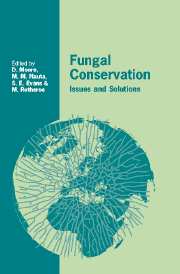Book contents
- Frontmatter
- Contents
- List of contributors
- Preface
- 1 Fungal conservation issues: recognising the problem, finding solutions
- 2 Current trends and perspectives for the global conservation of fungi
- 3 Conservation and management of forest fungi in the Pacific Northwestern United States: an integrated ecosystem approach
- 4 The future of fungi in Europe: threats, conservation and management
- 5 Fungi as indicators of primeval and old-growth forests deserving protection
- 6 Recognising and managing mycologically valuable sites in The Netherlands
- 7 Threats to hypogeous fungi
- 8 Wild mushrooms and rural economies
- 9 Threats to biodiversity caused by traditional mushroom cultivation technology in China
- 10 A preliminary survey of waxcap grassland indicator species in South Wales
- 11 Grasslands in the coastal dunes: the effect of nature management on the mycota
- 12 The conservation of fungi on reserves managed by the Royal Society for the Protection of Birds (RSPB)
- 13 Strategies for conservation of fungi in the Madonie Park, North Sicily
- 14 Fungal conservation in Ukraine
- 15 The threatened and near-threatened Aphyllophorales of Finland
- 16 Fungal conservation in Cuba
- 17 Microfungus diversity and the conservation agenda in Kenya
- 18 Fungi and the UK Biodiversity Action Plan: the process explained
- 19 The Scottish Wild Mushroom Forum
- 20 The contribution of national mycological societies: establishing a British Mycological Society policy
- 21 The contribution of national mycological societies: the Dutch Mycological Society and its Committee for Fungi and Nature Conservation
- 22 Fungal conservation in the 21st century: optimism and pessimism for the future
- Index
10 - A preliminary survey of waxcap grassland indicator species in South Wales
Published online by Cambridge University Press: 13 October 2009
- Frontmatter
- Contents
- List of contributors
- Preface
- 1 Fungal conservation issues: recognising the problem, finding solutions
- 2 Current trends and perspectives for the global conservation of fungi
- 3 Conservation and management of forest fungi in the Pacific Northwestern United States: an integrated ecosystem approach
- 4 The future of fungi in Europe: threats, conservation and management
- 5 Fungi as indicators of primeval and old-growth forests deserving protection
- 6 Recognising and managing mycologically valuable sites in The Netherlands
- 7 Threats to hypogeous fungi
- 8 Wild mushrooms and rural economies
- 9 Threats to biodiversity caused by traditional mushroom cultivation technology in China
- 10 A preliminary survey of waxcap grassland indicator species in South Wales
- 11 Grasslands in the coastal dunes: the effect of nature management on the mycota
- 12 The conservation of fungi on reserves managed by the Royal Society for the Protection of Birds (RSPB)
- 13 Strategies for conservation of fungi in the Madonie Park, North Sicily
- 14 Fungal conservation in Ukraine
- 15 The threatened and near-threatened Aphyllophorales of Finland
- 16 Fungal conservation in Cuba
- 17 Microfungus diversity and the conservation agenda in Kenya
- 18 Fungi and the UK Biodiversity Action Plan: the process explained
- 19 The Scottish Wild Mushroom Forum
- 20 The contribution of national mycological societies: establishing a British Mycological Society policy
- 21 The contribution of national mycological societies: the Dutch Mycological Society and its Committee for Fungi and Nature Conservation
- 22 Fungal conservation in the 21st century: optimism and pessimism for the future
- Index
Summary
Introduction
Over the past several decades conservationists have become increasingly concerned about the disappearance of traditionally managed meadows and pastures. These grasslands and their characteristic communities of native plants have been lost through treatment with artificial fertilisers and selective herbicides, through ploughing and reseeding and by encroaching development. It was against this background in 1987 that the Countryside Council for Wales (CCW) began a systematic survey of semi-natural grasslands in Wales (currently nearing completion), using the National Vegetation Classification (NVC) (Rodwell, 1991, et seq.) to define plant communities. As well as providing basic information on the distribution and extent of unimproved grassland, a further aim of this CCW survey was to identify the best examples of this habitat in Wales and to afford them official recognition and protection as Sites of Special Scientific Interest (SSSIs). These are areas of land or water which are designated as being of nature conservation importance for their biological, geological or physio-graphic features. Designation affords the site statutory protection and aims to secure its sympathetic management. Currently, there are more than 1000 SSSIs in Wales.
In parallel with vascular plants, a series of species of macrofungi is largely confined to, and therefore indicative of, traditionally managed grasslands. Such habitats are known to mycologists as Hygrocybe grasslands (Feehan & McHugh, 1992) or waxcap grasslands (Rotheroe et al., 1996). The genus Hygrocybe (waxcaps) is not the only fungal indicator of this grassland community.
- Type
- Chapter
- Information
- Fungal ConservationIssues and Solutions, pp. 120 - 135Publisher: Cambridge University PressPrint publication year: 2001
- 4
- Cited by



